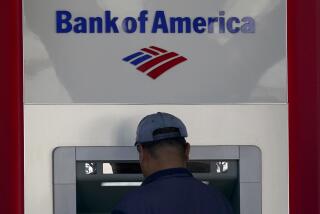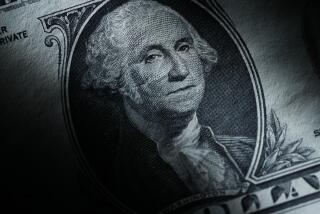B of A Raises Its Prime Lending Rate Back to 9% : Finance: The bank made the move because others did not follow its cut to 8.75%. It also no longer expects the Federal Reserve to force rates lower.
Bank of America, saying it no longer expects the Federal Reserve to force interest rates lower soon, on Wednesday raised its prime lending rate by a quarter point to 9%, putting it back in line with other major banks.
The move by the San Francisco-based bank to raise its prime--the rate on which many business and consumer loans are based--signals that banks are reluctant to lower their loan rates further, and may even raise them somewhat.
Prompted by Fed actions earlier this year to drive down rates, Bank of America and other major banks on Feb. 1 dropped their prime rates to 9% from 9.5%. When B of A lowered its prime again--to 8.75% from 9% on Feb. 20--it did so because Fed Chairman Alan Greenspan had suggested that the central bank might trigger a further decline in interest rates by lowering the discount rate, which is what banks pay to borrow from the Fed, Bank of America spokesman John Keane said.
“Since that time, the situation has changed,” Keane said. “There are now indications that there will be no (Fed) pressure to reduce interest rates further.”
Keane said B of A’s decision stemmed largely from comments Greenspan made Tuesday before the Senate Banking Committee. Greenspan said the Fed needs to be cautious about driving rates even lower because inflation remains a threat and the recession may be easing. The Fed had been driving rates lower since last summer in a bid to stimulate the economy. Lower rates spur borrowing by businesses and consumers, typically lifting economic activity.
Bank of America was a leader among major banks on Jan. 2, when it cut its prime rate to 9.5% from 10%. It also led the Feb. 1 cuts that left the prime at 9%. By taking the lead again and lowering its rate to 8.75%, the bank tried to quickly lure business from its competitors, some industry analysts say. Banks profit from the difference between interest they receive on loans made to customers and what they must pay to attract depositors.
Analysts say the strategy failed because other banks, more than two months later, did not follow B of A’s lead--leaving it at a disadvantage.
“They lowered the rate to 8.75% because it appeared the Federal Reserve would push rates lower,” said Campbell Chaney of Sutro & Co. in San Francisco. “But B of A was also trying to establish itself again as a (banking) leader. The bank may have been trying to flex its muscles. When no one else followed suit by cutting rates, it was out on a limb.”
A Bank of America affiliate, Seattle First National Bank, on Wednesday also raised its prime back to 9%.
More to Read
Inside the business of entertainment
The Wide Shot brings you news, analysis and insights on everything from streaming wars to production — and what it all means for the future.
You may occasionally receive promotional content from the Los Angeles Times.










